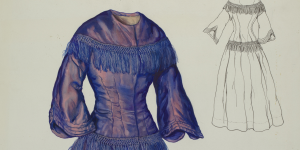On Saturday, a group of of mostly older D.C. residents sat on blue butterfly stools facing Jean Miro’s The Farm for the third session of this season’s Writing Salons at the National Gallery of Art. Each session takes a couple of hours to help writers focus on developing a different theme or genre within writing through exploration of visual art. This session, centered on the theme of memoirs, offered attendees the opportunity to deepen their connection to Miro’s painting while reflecting on their own lives through a series of writing exercises led by playwright Mary Hall Surface.
Surface began by explaining that these sessions provide a novel way to explore visual art. In this session, attendees had the chance to explore Miro’s painting from a writer’s perspective, using it as a vehicle for personal reflection, expressing in words what Surface called “a slice of life.” Surface enhanced the experience with details about the painting and Miro that gave the writers exciting and relevant insights.
Over the course of nine months, for eight hours a day, seven days a week, Miro sat across from the canvas reflecting on Mont-roig in the Catalonian countryside, where his parents had bought a farm when the artist was nineteen. Near his hometown of Barcelona, this farm, Miro felt, was representative of his grandparents’ generation. The young artist spent several summers on Mont-roig and wanted to include every element he loved about it, from a great big tree in the center of the piece, to a tiny snail in the lower right-hand corner.
Miro’s personal connection to his subject and the painting’s surrealist elements serve as an excellent parallel to this Writing Salon’s theme of memoir. In contrast to autobiographies, memoirs allow writers to creatively recount past experiences in a way that invites their readers to reflect on their own lives and answer important existential questions. Additionally, as Surface added, memoir allows the memoirist to better understand a memory–what it meant to them at the time, and what it means for them presently.
In the session’s initial stages, Surface led the group through a series of observational exercises, asking them to identify objects and animals, and then add descriptive terms about them. These simplistic exercises led to more thought-provoking prompts such as asking the writers to compose a reflection about certain subjects in the painting from the artist’s perspective. Consequently, writers could more carefully consider Miro’s artistic choices. These considerations sparked the realization of new possibilities that the writers could draw from to creatively structure their pieces. For instance, the farm in the painting is brightly lit, but the orb in the sky could be either the sun or the moon, helping generate ideas about the non-linear usage of time in writing.
Surface asked the group what question Miro’s painting posed to them, what question they’d want their own memoir to explore, and what was one place and symbol they identified with. For Miro, his family’s farm in Mont-roig and a ladder were respectively a place and a symbol he frequently explored. Despite Miro’s taste for the cosmopolitan lifestyle, which led him to live in several cities, his family’s Mont-roig farm had been a formative place for him.
He painted two more renditions of The Farm, each increasingly surrealist. Every depiction includes a ladder, which for Miro expressed a bridge between the terrestrial and the celestial, from reality to imagination, according to Surface. The ladder acts as a symbol of surrealism, which serves the same purpose of connecting the abstract and tangible, similar to the way creative, unrealistic elements in writing can be used to express what cannot be perceived in a literal sense.
For Miro, The Farm captured details of his past experiences that were personally meaningful, yet for viewers evoked certain feelings that gave them their own personal connection to the piece. In line with the theme of memoir, this painting once belonged to Ernest Hemingway, who bought it in Paris with the little money he had at the time. Fittingly, in his memoir on Paris, A Moveable Feast, Hemingway shares that due to his starving-artist lifestyle, Gertrude Stein once told him, “You can either buy clothes or buy pictures. . . . buy your clothes for comfort and durability, and you will have the clothes money to buy pictures.”
When Hemingway first saw the painting, he was enamored by the way that it expressed what he most loved about Spain. He had to have it. He bought the painting in Paris and gave it to his first wife Hadley as a birthday gift. After their divorce, he asked if he could borrow the painting. The novelist/memoirist never returned it, and The Farm remained and traveled with him throughout his life. After Hemingway’s death, his fourth and final wife donated The Farm to D.C.’s National Gallery of Art, where a group of amateur writers could find a piece of themselves in this creative mélange of art, memory, and expression.
The Writing Salon gives museum-goers the opportunity to immerse themselves in the world of an artist through the creative medium of writing. Surface provides the writers with an excellent balance of relevant history, details, questions, and time to foster a unique and multifaceted relationship to visual art through writing. This creates the artist’s ideal space, where art generates and gains new meaning through art.





